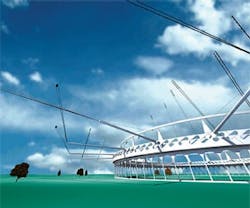Ground-Breaking Alternative Energy Options
Alternative energy options are always being improved – the options grow every year. Here, we cover some up-and-coming trends in alternative energy that you’re likely to see crop up in commercial facilities as they become more mainstream.
Harvesting Ambient and Waste Energy
Duke University engineers are hoping to harvest ambient energy from the motions of everyday life. Everyday motions are normally wasted, remain unused, and dissipate in the form of heat. The device that Duke is developing to capture this energy is a small cantilever (several inches long and one-quarter-inch wide). It has an end magnet that interacts with nearby magnets to "tune" the interactions of the system with its environment. The base consists of a material that releases electrical voltage when it’s strained. The range of applications for this technology is almost unlimited.
Strides are also being made in terms of another type of energy: waste energy. Robert DiMatteo, head of MTPV Corp., says that, worldwide, when we consume fuel, or when a powerhouse generates electricity, nearly 60 percent of all the energy is wasted (generally in the form of heat). When we use different gadgets or equipment, some of that energy is lost in the form of friction or heat. New technology from MIT researchers could make it possible to reclaim a significant portion of that wasted energy. If it can be harvested, we could double the battery life of a cell phone or laptop.
Kites Capture Wind
The ability to capture wind energy isn’t necessarily news, but did you know that most of the available wind energy is located at a high altitude –and today’s wind turbines can’t reach that high? Enter the kite wind generator. These "kites" sprout from funnel-like structures and are mounted on poles. High-resistance cables control their direction and angle. These kites are light and resistant, especially when compared to turbines. The technology behind them doesn’t require acres of space, like wind turbines do. And advanced radar systems can redirect the kites within seconds if birds are detected nearby.
Heating and Cooling from Carbon
Researchers at the University of Warwick have invented a different use for carbon – they’re using carbon for cooling and heating. Even the best boilers are only about 90 percent efficient, so there is room for improvement in this area. The team is trying to devise a new way of using adsorption technology (adhesion of molecules of gas, liquid, or dissolved solids to a
surface) for heating and cooling. University of Warwick researchers have formulated adsorption systems that use thin sheets of metal throughout the active carbon in the heat exchanger. Every sheet holds about 100 tiny water channels. This makes the heat transfer much more efficient. These water sheets shrink the adsorption-based equipment to 20 times smaller than was formerly possible. The team believes that their new adsorption technology will reduce the electricity used by heating and cooling equipment by up to 30 percent.
Solar Power
Robins Air Force Base in Houston County, GA, recently installed a solar panel that contains sensors. The sensor technology in the panels tracks the sun automatically, and its concentrated photovoltaic array technology amplifies the sun’s power by 500 to 1,000 times. (To accomplish this feat, they use magnifying glasses.) These solar panels are able to trap 38 percent of the energy from sunlight (earlier solar panels captured only about 8 percent) and have an estimated life of 25 years.
Another way to capture energy from the sun is being implemented at Dell. Its solar trees parking lot, located at Dell’s headquarters in Round Rock, TX, is a sign of greater things to come. Each solar tree not only gathers the sun’s energy, but also provides shade for approximately 50 parking spaces. The electricity generated via the sun’s rays is stored and can be used to light the parking lot at night. And not only do these solar trees run off of their own electricity, but they also have the ability to provide power to charging stations for electric cars.
Leah B. Garris ([email protected]) is managing editor at Buildings magazine.
